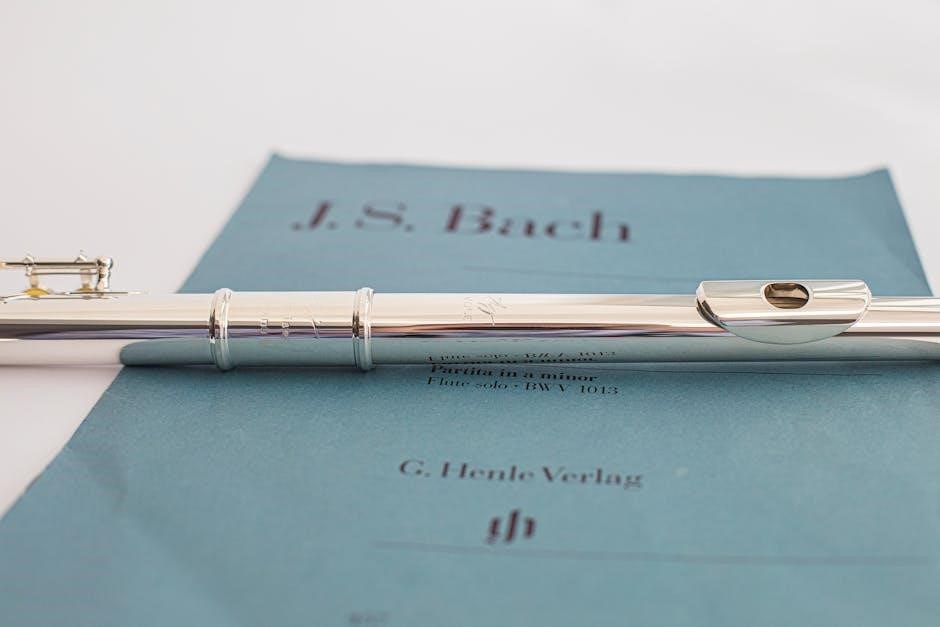Johann Sebastian Bach’s Inventions are a collection of 30 keyboard works, including 15 two-part and 15 three-part compositions, designed for educational purposes.
1.1 Definition and Historical Context
Johann Sebastian Bach’s Inventions are a set of 30 keyboard compositions, comprising 15 two-part and 15 three-part works. Written around 1720–1723, they were intended as pedagogical pieces for Bach’s students, including his son Wilhelm Friedemann. The term “Invention” reflects Bach’s innovative approach to teaching counterpoint and keyboard technique. These works emphasize clarity, precision, and musical logic, serving as foundational exercises in composition and performance. They remain central to Bach’s educational legacy and are widely studied today for their technical and artistic value.
1.2 Purpose of the Inventions
Bach’s Inventions were primarily composed as educational tools to teach counterpoint, keyboard technique, and musical structure. Designed for his students, including his son Wilhelm Friedemann, these works aimed to develop compositional skills and technical mastery. They served as exercises to enhance understanding of musical logic, clarity, and precision. The Inventions also preserved musical techniques for future generations, ensuring their enduring educational value. Today, they remain essential for studying Bach’s pedagogical methods and compositional genius.

Structure of the Two-Part Inventions
The Two-Part Inventions are a collection of 15 short keyboard works, designed as exercises to teach counterpoint and keyboard technique. Their organized layout reflects Bach’s systematic educational approach, emphasizing clarity and precision. The Langloz manuscript further highlights their connection to Bach’s compositional style, offering insights into his pedagogical methods and musical structure.
2.1 Composition and Layout
Bach’s Two-Part Inventions are structured with a clear beginning, middle, and end, often featuring a subject introduced at the outset. The compositions frequently incorporate fugal techniques, where the subject is developed and interwoven between the two parts. The layout is designed to enhance clarity, with each invention typically unfolding in a logical progression. This organized structure not only aids in teaching counterpoint but also provides a foundation for understanding Bach’s compositional principles. The Langloz manuscript further supports this educational intent, offering insights into Bach’s systematic approach to musical instruction.
2.2 Key Features and Musical Elements
Bach’s Two-Part Inventions are characterized by their clarity and systematic structure, emphasizing the interplay between two voices. Each invention features a subject presented in one part, with the other part responding in a fugal manner. The compositions showcase Bach’s mastery of counterpoint, with techniques like inversion and stretto used to develop musical ideas. The pieces are designed to demonstrate contrapuntal principles while maintaining a balanced and engaging dialogue between the voices, reflecting Bach’s intent to educate through musical clarity and precision.

Structure of the Three-Part Inventions (Sinfonias)
Bach’s Three-Part Inventions, or Sinfonias, are complex works featuring interweaving themes across three voices, showcasing advanced counterpoint and fugal techniques in a structured, educational format.
3.1 Composition and Layout
Bach’s Three-Part Inventions, or Sinfonias, consist of 15 pieces, each structured with three independent voices. These compositions emphasize counterpoint and fugue, with intricate interplay between voices. The layout often features a principal theme introduced in one voice, followed by its development across the others. This design not only showcases Bach’s mastery of polyphony but also serves as a pedagogical tool, helping students understand complex musical structures. The Sinfonias are typically more elaborate than the two-part inventions, reflecting advanced compositional techniques.
3.2 Key Features and Musical Elements
Bach’s Three-Part Inventions are characterized by their intricate counterpoint, with each voice functioning independently yet harmoniously. They feature invertible counterpoint, allowing voices to interchange parts without losing coherence. Thematic development is central, with motifs often appearing in various guises. The interplay of voices creates a rich harmonic texture, while maintaining clarity and balance. These works showcase Bach’s mastery of fugue and polyphony, blending complexity with elegance. The Sinfonias are both musically rewarding and pedagogically valuable, exemplifying Bach’s compositional genius.
Historical Significance of the Inventions
Bach’s Inventions are foundational to Western music education, showcasing his pedagogical brilliance and influencing composers like Mozart and Beethoven. They remain essential for understanding Baroque musical evolution.
4.1 Bach’s Pedagogical Intentions
Bach’s Inventions were primarily pedagogical compositions, designed to teach counterpoint, clarity, and precision in composition. They aimed to develop students’ understanding of thematic development and harmonic structure. By focusing on concise and well-structured pieces, Bach provided a foundation for young composers to master musical craftsmanship. These works reflect his commitment to fostering technical skill and artistic expression, ensuring their enduring value in music education and composition studies.
4.2 Influence on Later Composers
Bach’s Inventions profoundly influenced later composers, shaping the development of classical music. Composers like Mozart and Beethoven studied these works, adopting Bach’s contrapuntal techniques and structural clarity. The Inventions’ emphasis on thematic development and harmonic innovation inspired generations, becoming a cornerstone of musical education and composition. Their influence extends to modern times, with arrangers and performers continually reinterpretating these works, ensuring Bach’s pedagogical legacy endures in diverse musical traditions and styles.

The Role of the Langloz Manuscript
The Langloz Manuscript, a collection of partimenti, offers insights into Bach’s compositional style and pedagogical methods, enhancing modern understanding and educational applications of his works.
5.1 Connection to Bach’s Compositional Style
The Langloz Manuscript reflects Bach’s compositional principles, offering insights into his use of counterpoint, harmony, and structural clarity. It demonstrates his methodical approach to teaching musical fundamentals, as seen in his Inventions. The manuscript’s partimenti exercises align with Bach’s emphasis on practical learning, showcasing his ability to balance technical rigor with artistic expression. This connection underscores Bach’s role as both a master composer and a dedicated educator, influencing modern interpretations of his works.
5.2 Pedagogical Use in Modern Times
The Langloz Manuscript remains a vital tool in modern music education, offering insights into Bach’s pedagogical methods. Its partimenti exercises and contrapuntal studies provide a bridge between historical techniques and contemporary teaching. Educators use these materials to help students grasp counterpoint, harmony, and structural analysis, aligning with Bach’s intent to cultivate musical understanding. This manuscript is particularly valued for its practical approach, making Bach’s compositional style accessible to learners of all levels, ensuring his legacy endures in modern musical training and performance practices.

Analyzing Bach’s Inventions
Bach’s Inventions offer a rich terrain for analytical exploration, with intricate counterpoint, harmonic innovation, and structural precision. The Langloz Manuscript provides valuable insights into Bach’s compositional style.
6.1 Counterpoint and Fugue Techniques
Bach’s Inventions exemplify his mastery of counterpoint, with intricate interweaving of voices that demonstrate strict fugue techniques. The Langloz Manuscript highlights Bach’s use of imitation and stretto, showcasing his compositional precision. These pieces illustrate how Bach taught complex contrapuntal writing through clear, structured exercises. The Inventions’ clarity and balance serve as a foundation for understanding Bach’s fugue techniques, making them essential for studying his contrapuntal genius and pedagogical methods.
6.2 Harmonic and Structural Analysis
Bach’s Inventions showcase his meticulous use of harmonic progression and structural clarity. The pieces often feature chordal sequences and tonal harmony, balanced with contrapuntal complexity. PDF scores reveal Bach’s systematic approach, with each invention demonstrating a specific harmonic technique. The clear beginning, middle, and end structure provides a framework for understanding his compositional logic. These works are not only musically elegant but also serve as masterclasses in harmonic and structural precision, making them invaluable for study and performance.
Performance Practice
Bach’s Inventions require precise tempo, clear articulation, and nuanced dynamics. Czerny suggests 138 BPM for the first invention, emphasizing rhythmic clarity and expressive interpretation, as seen in PDF scores.
7.1 Tempo and Articulation
Bach’s Inventions are typically performed at moderate tempos, with the first invention suggested at 138 BPM by Czerny. Articulation should be precise, emphasizing clarity in counterpoint. Legato playing is often preferred for smoothness, while detached notes highlight intricate passages. Historical performance practices suggest using varied articulations to enhance musicality. Modern interpretations may slightly adjust tempos for expressive purposes, but maintaining rhythmic accuracy is crucial. PDF scores often include tempo markings and phrasing guides to aid performers in achieving authentic renditions of these works.
7.2 Dynamics and Interpretation
Bach’s Inventions, composed during the Baroque era, generally lack explicit dynamic markings. However, performers are encouraged to apply subtle dynamic contrasts through phrasing and articulation. A light touch is often favored in faster movements, while slower pieces may benefit from expressive shading. The sustain pedal should be used sparingly to maintain clarity. Modern interpretations sometimes incorporate dynamic variations for dramatic effect, though this remains subjective. PDF scores often include suggested dynamic markings, guiding performers in creating nuanced, historically informed renditions of these timeless works.
Educational Value of the Inventions
Bach’s Inventions are invaluable for developing composition and performance skills, offering structured exercises in counterpoint, harmony, and keyboard technique, essential for both composers and performers.
8.1 Development of Composition Skills
Bach’s Inventions are fundamental for cultivating composition skills, offering insights into counterpoint, harmonic structure, and thematic development. By studying these works, composers learn to craft coherent musical ideas, balance voices, and manipulate motifs effectively. The pieces exemplify precise contrapuntal techniques and inventive use of musical material, providing a model for creating complex yet elegant compositions. Analyzing and performing these inventions enhances one’s understanding of musical architecture and technical mastery, making them indispensable for compositional training and artistic growth.
8.2 Technical Mastery for Performers
Bach’s Inventions are renowned for their technical demands, offering performers a rigorous framework to refine dexterity, phrasing, and control. The intricate counterpoint and precise articulation require meticulous practice, fostering finger independence and rhythmic accuracy. Tempo recommendations, such as Czerny’s suggested 138 BPM for the first invention, guide performers in achieving clarity and flow. These works also enhance dynamic expression and interpretative skills, making them essential for pianists seeking to master Baroque keyboard techniques and elevate their overall performance quality through dedicated study and execution;
Available Resources and Editions
PDF scores and study materials for Bach’s Inventions are widely available, along with modern transcriptions and guides for performers and scholars.
9.1 PDF Scores and Study Materials
High-quality PDF scores of Bach’s Inventions are readily available online, offering clear and accurate representations of the original compositions. Many resources provide Urtext editions, ensuring authenticity and faithfulness to Bach’s intent. Study materials often include analytical notes, historical context, and performance tips, aiding both scholars and performers. Additionally, interactive PDFs with embedded audio and adjustable tempos are popular for educational purposes. These resources are invaluable for musicians seeking to master Bach’s intricate compositions and understand their historical significance.
9.2 Modern Transcriptions and Guides
Modern transcriptions of Bach’s Inventions are widely available, offering fresh perspectives on his timeless compositions. Guides often include detailed analyses, performance suggestions, and historical insights, making the works more accessible to contemporary musicians. Some resources feature transcriptions for various instruments, while others provide step-by-step tutorials for learners. These modern interpretations preserve Bach’s original intent while adapting his music to suit today’s diverse musical needs and educational approaches.
Cultural and Artistic Legacy
Bach’s Inventions profoundly influenced classical music, shaping compositional techniques and educational practices. Their timeless appeal ensures continued relevance, inspiring modern arrangements and interpretations across genres.
10.1 Impact on Classical Music Tradition
Bach’s Inventions laid the foundation for Western musical education, emphasizing counterpoint and compositional structure. Their influence is evident in later composers like Haydn and Beethoven, who studied these works. The pieces remain cornerstone exercises for developing musicians, showcasing Bach’s mastery and enduring legacy in classical music tradition. His innovative use of fugue and harmonic techniques continues to inspire composers and educators, solidifying the Inventions’ role in shaping musical history and pedagogy.
10.2 Modern Interpretations and Arrangements
Bach’s Inventions have inspired modern interpretations across genres, from classical performances to jazz and electronic arrangements. Digital editions like PDF scores facilitate accessibility, enabling global musicians to study and perform these works. Contemporary composers often integrate Bach’s counterpoint techniques into their music, ensuring his influence endures. These reinterpretations not only honor Bach’s legacy but also introduce his compositions to new audiences, highlighting the timeless appeal of his work in today’s diverse musical landscape.